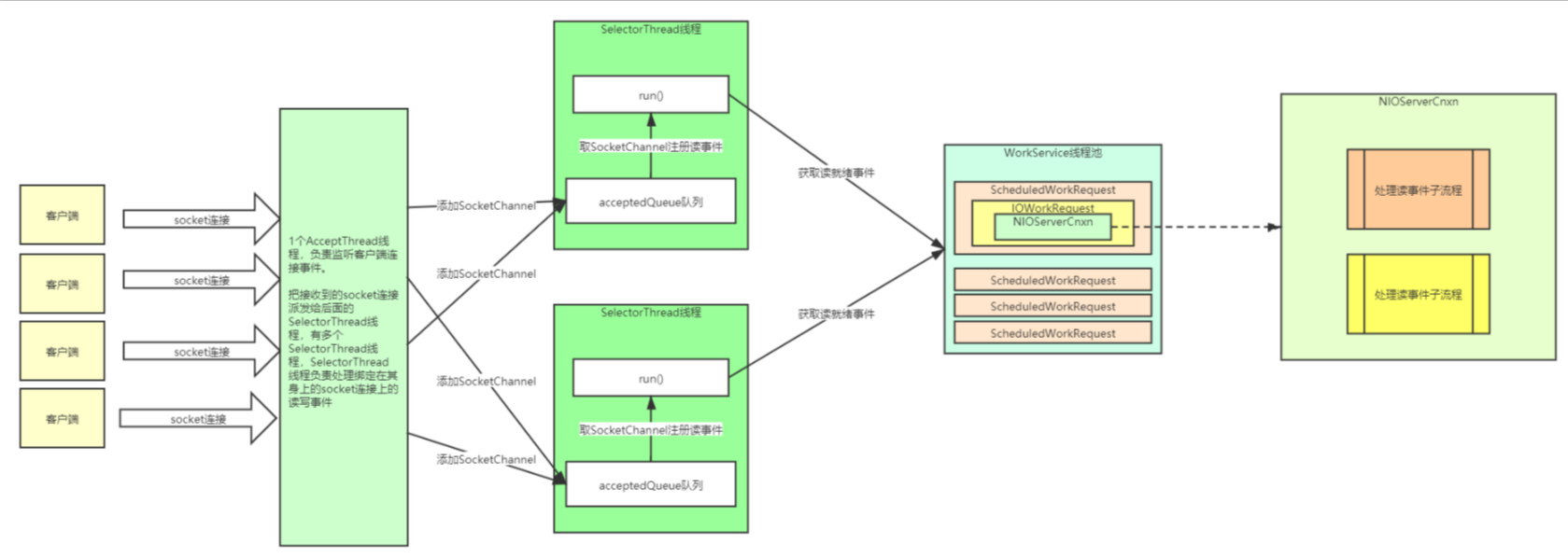
SelectorThread可以通过JVM参数指定,表示多路复用器。
每一个客户端生成一个SocketChannel,多个或一个SocketChannel与SelectorThread绑定。
详细描述如下:
-
会有若干个客户端由AcceptThread线程去接收socket连接,客户端与ZKServer取得连接。每存在一个连接就有一个SocketChannel
- 同时也会生成一个NIOServerCnxn,这个上下文对象在下文有“大用处”
-
SocketChannel与SelectorThread(多路复用选择器)绑定到一起,作为请求的传输通道
- 每产生一个SocketChannel对象就会作为SelectorThread对象的acceptedQueue属性与SelectorThread绑定。
-
SelectorThread监听接收就绪事件
- SelectorThread会不断的从acceptedQueue中读取SocketChannel对象,作为注册事件读到SelectorThread的selector中。同时SelectorThread也会不断地从selector中读取就绪事件
-
处理请求的方式
- 每获取到一个就绪事件就会封装成一个IOWorkRequest对象
- 然后会将IOWorkRequest对象封装成一个ScheduleWorkRequest对象(线程)
- 将Schedule对象放到线程池中执行
- 线程池执行时调用IOWorkRequest对象的doWork()方法。
public void doWork() throws InterruptedException { if (!key.isValid()) { selectorThread.cleanupSelectionKey(key); return; } // 读就绪或写就绪 if (key.isReadable() || key.isWritable()) { // 处理key // 到这里,多个客户端请求还是并发处理的 cnxn.doIO(key); // 顺序 // Check if we shutdown or doIO() closed this connection if (stopped) { cnxn.close(ServerCnxn.DisconnectReason.SERVER_SHUTDOWN); return; } if (!key.isValid()) { selectorThread.cleanupSelectionKey(key); return; } touchCnxn(cnxn); } // Mark this connection as once again ready for selection cnxn.enableSelectable(); // Push an update request on the queue to resume selecting // on the current set of interest ops, which may have changed // as a result of the I/O operations we just performed. if (!selectorThread.addInterestOpsUpdateRequest(key)) { cnxn.close(ServerCnxn.DisconnectReason.CONNECTION_MODE_CHANGED); } }
- 可以看到,doWork方法内部调用的就是NIOServerCnxn的doIO方法。所以doIO()方法是zkServer真正处理客户端请求的方法(处理CRUD等请求)
void doIO(SelectionKey k) throws InterruptedException { try { if (!isSocketOpen()) { LOG.warn("trying to do i/o on a null socket for session: 0x{}", Long.toHexString(sessionId)); return; } if (k.isReadable()) { // 读就绪,把数据读到incomingBuffer中, int rc = sock.read(incomingBuffer); // 45 一开始读4个字节数据,也就是读数据包的长度 // if (rc < 0) { // 没有读到数据则报错 handleFailedRead(); } // 表示还有没有剩余空间可以读数据 if (incomingBuffer.remaining() == 0) { boolean isPayload; // 读到的是长度 if (incomingBuffer == lenBuffer) { // start of next request incomingBuffer.flip(); isPayload = readLength(k); incomingBuffer.clear(); // 54byte } else { // 读到的是真正的packet数据(也就是命令) // continuation isPayload = true; } if (isPayload) { // not the case for 4letterword // 处理命令 readPayload();//读数据 } else { // four letter words take care // need not do anything else return; } } } if (k.isWritable()) { // 从outgoingBuffers中获取数据进行写入(返回给客户端) handleWrite(k); if (!initialized && !getReadInterest() && !getWriteInterest()) { throw new CloseRequestException("responded to info probe", DisconnectReason.INFO_PROBE); } } } catch (CancelledKeyException e) { LOG.warn("CancelledKeyException causing close of session: 0x{}", Long.toHexString(sessionId)); LOG.debug("CancelledKeyException stack trace", e); close(DisconnectReason.CANCELLED_KEY_EXCEPTION); } catch (CloseRequestException e) { // expecting close to log session closure // 移除watcher,并关闭socket close(); } catch (EndOfStreamException e) { LOG.warn("Unexpected exception", e); // expecting close to log session closure close(e.getReason()); } catch (ClientCnxnLimitException e) { // Common case exception, print at debug level ServerMetrics.getMetrics().CONNECTION_REJECTED.add(1); LOG.warn("Closing session 0x{}", Long.toHexString(sessionId), e); close(DisconnectReason.CLIENT_CNX_LIMIT); } catch (IOException e) { LOG.warn("Close of session 0x{}", Long.toHexString(sessionId), e); close(DisconnectReason.IO_EXCEPTION); } }

- 线程池执行时调用IOWorkRequest对象的doWork()方法。